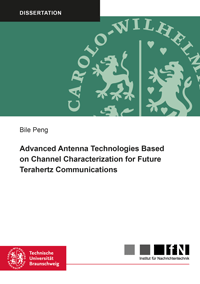
Shop : Weiterempfehlung
Shop
Weiterempfehlung
48,80 €ISBN 978-3-8440-6519-0Paperback192 Seiten84 Abbildungen285 g21 x 14,8 cmEnglischDissertation
März 2019
Bile Peng
Advanced Antenna Technologies Based on Channel Characterization for Future Terahertz Communications
The terahertz (THz) communication utilizes the frequency resource beyond 300 GHz and is considered as a promising solution to the future indoor multi-gigabit data transmission due to the huge available bandwidth (up to 50 GHz). The latest development of the semiconductor technology and diverse demonstrators show that the THz communication is not only a long term vision, but can be an actual breakthrough in the upcoming years.
However, the so far realized THz demonstrators only work in relatively simple scenarios, where the wireless channels are stationary. The objective of this dissertation is to apply the THz communication to wireless personal area network (WPAN) and wireless local area network (WLAN), where the wireless channel is characterized by rich multipath components (MPC) and dynamics, with the aid of advanced antenna technologies. In particular, we consider angle of arrival (AoA) estimation for adaptive directive antennas and precoding and detection for broadband massive multiple-input-multiple-output (MIMO).
The performance of the considered antenna technologies depends largely on the channel characteristics. Therefore, the dissertation begins with channel measurement with vector network analyzer (VNA), channel sounder (CS) and channel modeling with ray-tracing and ray-launching simulations in the considered application scenarios. The simulation results are compared with and calibrated according to the measurement results. A new method based on the Hungarian algorithm and space alternating generalized expectationmaximization (SAGE) algorithm is developed to calibrate the electromagnetic parameters of materials. Based on the comprehensive channel measurement and simulation results, the most important characteristics of the THz channels are summarized for the design and justification of the later introduced algorithms.
The AoA estimation is required for the application of adaptive directive antennas. However, a trivial beam searching process is considered impractical due to its time consumption. Various researches show that the spatial distribution of propagation paths at different frequency ranges are similar. Based on this observation, a two-phase AoA estimation algorithm is proposed. In the first phase, the AoA is roughly estimated with a low frequency (say, 5 GHz); In the second phase, the precise AoA estimation is carried out at the THz range within the range defined in the first phase. In this way, the precise AoA can be estimated within a short period of time.
Furthermore, the dynamic AoA estimation problem is considered, where the user equipment (UE) is moving during the data transmission. Since the AoA change is temporally correlated (because the human movement shows certain statistical patterns), a finitememory-based hidden Markov model (HMM) is applied to describe the AoA change along time and the forward-backward algorithm is applied for the AoA estimation. In addition, if there are several access point (AP) antennas, the AoA changes at different AP antennas are spatially correlated because all the AoA changes are due to the same UE displacement. This spatial correlation can be presented in an extended probabilistic graphical model and be utilized with belief propagation to further improve the estimation precision.
Besides the directive antenna, massive MIMO is another promising antenna technology to realize high antenna gain and reduce interference. In this dissertation, the massive MIMO precoding and detection problems for single carrier broadband channel with delay dispersion is addressed. The block matrix is used to describe the distortion effect of the channel on the transmitted signal. The power-constraint downlink precoding problem is solved with the Lagrange multiplier and the uplink detection coefficients are obtained with the orthogonality principle. The least square least square QR (LSQR) algorithm is applied to efficiently solve the optimization problem in real time. Simulation results show that a good system performance is achieved with reasonable computational effort.
However, the so far realized THz demonstrators only work in relatively simple scenarios, where the wireless channels are stationary. The objective of this dissertation is to apply the THz communication to wireless personal area network (WPAN) and wireless local area network (WLAN), where the wireless channel is characterized by rich multipath components (MPC) and dynamics, with the aid of advanced antenna technologies. In particular, we consider angle of arrival (AoA) estimation for adaptive directive antennas and precoding and detection for broadband massive multiple-input-multiple-output (MIMO).
The performance of the considered antenna technologies depends largely on the channel characteristics. Therefore, the dissertation begins with channel measurement with vector network analyzer (VNA), channel sounder (CS) and channel modeling with ray-tracing and ray-launching simulations in the considered application scenarios. The simulation results are compared with and calibrated according to the measurement results. A new method based on the Hungarian algorithm and space alternating generalized expectationmaximization (SAGE) algorithm is developed to calibrate the electromagnetic parameters of materials. Based on the comprehensive channel measurement and simulation results, the most important characteristics of the THz channels are summarized for the design and justification of the later introduced algorithms.
The AoA estimation is required for the application of adaptive directive antennas. However, a trivial beam searching process is considered impractical due to its time consumption. Various researches show that the spatial distribution of propagation paths at different frequency ranges are similar. Based on this observation, a two-phase AoA estimation algorithm is proposed. In the first phase, the AoA is roughly estimated with a low frequency (say, 5 GHz); In the second phase, the precise AoA estimation is carried out at the THz range within the range defined in the first phase. In this way, the precise AoA can be estimated within a short period of time.
Furthermore, the dynamic AoA estimation problem is considered, where the user equipment (UE) is moving during the data transmission. Since the AoA change is temporally correlated (because the human movement shows certain statistical patterns), a finitememory-based hidden Markov model (HMM) is applied to describe the AoA change along time and the forward-backward algorithm is applied for the AoA estimation. In addition, if there are several access point (AP) antennas, the AoA changes at different AP antennas are spatially correlated because all the AoA changes are due to the same UE displacement. This spatial correlation can be presented in an extended probabilistic graphical model and be utilized with belief propagation to further improve the estimation precision.
Besides the directive antenna, massive MIMO is another promising antenna technology to realize high antenna gain and reduce interference. In this dissertation, the massive MIMO precoding and detection problems for single carrier broadband channel with delay dispersion is addressed. The block matrix is used to describe the distortion effect of the channel on the transmitted signal. The power-constraint downlink precoding problem is solved with the Lagrange multiplier and the uplink detection coefficients are obtained with the orthogonality principle. The least square least square QR (LSQR) algorithm is applied to efficiently solve the optimization problem in real time. Simulation results show that a good system performance is achieved with reasonable computational effort.
Schlagwörter: THz communication; channel modeling; AoA estimation; Bayesian inference; massive MIMO; signal processing
Mitteilungen aus dem Institut für Nachrichtentechnik der Technischen Universität Braunschweig
Herausgegeben von Prof. Dr.-Ing. U. Reimers, Prof. Dr.-Ing. T. Kürner und Prof. Dr.-Ing. T. Fingscheidt, Braunschweig
Band 58
Die Weiterempfehlung wird per E-Mail an die von Ihnen unten angegebene Adresse verschickt.
Die mit einem * gekennzeichneten Felder sind Pflichtfelder! Bitte füllen Sie diese unbedingt vollständig aus.
Shaker Verlag GmbHAm Langen Graben 15a52353 Düren
Mo. - Do. 8:00 Uhr bis 16:00 UhrFr. 8:00 Uhr bis 15:00 Uhr
Kontaktieren Sie uns. Wir helfen Ihnen gerne weiter.



